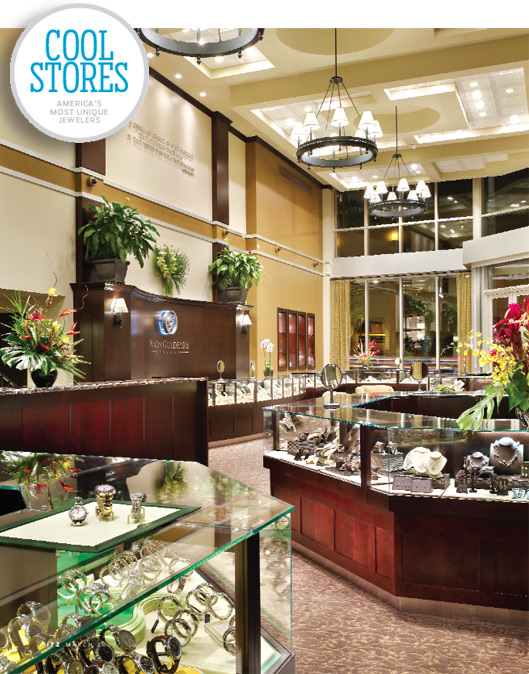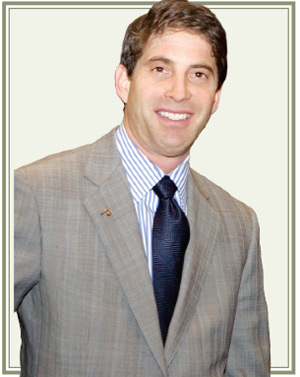A Washington state store goes new-millennium.

ALVIN GOLDFARB JEWELER
BELLEVUE, WA
URL: goldfarbjeweler.com
FOUNDER: Alvin Goldfarb
CURRENT PRESIDENT: Steven B. Goldfarb
YEAR FOUNDED: 1980
SLOGAN: “Something to celebrate”
STORE AREA: 1,800-square-foot showroom, 5,000-square-foot work space
EMPLOYEES: 25 in two stores
DESIGN TEAM: The Retail Group, Gregory Development and Northwest Building Tech
COST: $500,000
TOP-SELLING BRANDS: Watches — Rolex, Breitling, Omega, Jaeger LeCoultre, Panerai and Cartier; jewelry — Roberto Coin, Mikimoto, Gregg Ruth, Kwiat, Hearts On Fire and Wellendorff
Steven B. Goldfarb won’t deny sleeping on the job. The president of Alvin Goldfarb Jeweler essentially moved into the second story of its Bellevue, WA, store while it was still being remodeled from a 1920s-vintage grain and feed building into a new-millennium jewelry store. The resident president could answer any contractors’ questions immediately — and keep an eye on his inventory during the transition. Customers were ushered upstairs with a sense of humor: “We laughed and joked about them visiting our kitchen,” recalls Goldfarb. In 2-1/2 weeks his company had a totally remodeled store, and its president needed some rejuvenation himself. “I was so tired,” he admits. — HARRIET HOWARD HEITHAUS
Five Cool Things About This Store
Renovated Showroom: Need-Based Areas
1 They’re fearless. Goldfarb started planning the remodeling of the Bellevue flagship store months after entering the Seattle market with a gleaming glass-and-chrome building in 2007. Unfortunately, the Bellevue building was booby-trapped from years of other remodelings. One sink drained via a sump pump, an unused chimney stood in the middle of the store and there were walls, walls and more walls to tear down. Goldfarb hired a contractor who could work around the clock to create an open floor plan and a 5,000-square-foot space for goldsmith and cleaning/repair work. The $500,000 remodel created a U-shaped showroom with 1,800 square feet divided into areas designed for specific needs. Across its center are jewelry and giftware. One “arm” contains a watch salon dedicated to high-end timepieces. In the opposite “arm” are what Goldfarb calls the “not-so-romantic” aspects of jewelry — ringing up all sales, cleaning jewelry, taking in and delivering repairs and gift wrapping. That division of space frees the sales staff to concentrate on selling.
Advertisement
Brands: Paramount Placement
2 You know you can find your favorites here. Alvin Goldfarb Jeweler found its entre in the Seattle market by promoting brand names. It sets up its website to drive viewers directly to those specialties through its “Designer” drop-down. Placement is paramount in-store: While its watch business is within the salon, ultra-favorites Rolex and Cartier are promoted with lighted wall logos in the main showroom. Watches make up 40 percent of the company’s sales. “It’s the only jewelry guys get to wear generally,” Goldfarb says. Bellevue now has a computer with wireless reception on which customers can search for specific items or brands. They can also watch their jewelry being repaired or designed in the glass-windowed workshops on the upper level.
Lighting: LED the Way
3They’re making a distinctive statement. “It’s really about the lighting. LED lights weren’t a viable option until this year, but if you want to make jewelry really pop, they’ll do it. It’s really intense,” Goldfarb says. The Bellevue store’s walls also sparkle with lighted displays of the crystal it carries: Baccarat, Lalique and Waterford. New deeper, warm wood-tone cases offer more display, less crowding. Sumptuous-looking niched wood cases at storefront pull the eye toward them. Plentiful mirrors invite the customer to try something on. Then there’s that fireplace. “Every jewelry store has nice carpeting. The fireplace makes our store different. You’ll remember a store because it has something distinctive like that,” Goldfarb says.
Pup-Friendly: Two Kinds of Dogs
4They love dogs. Leashed dogs are always welcome at Alvin Goldfarb Jeweler, where the staff keep canine treats on hand. The stores offers Baccarat animals, and increased sales substantially on the advice of their distributor. The rep pointed out that Goldfarb could commission a design he felt would sell. “We got the idea that we’d like a Husky, which is the mascot for the University of Washington. That was a fun project — it’s not huge, but we sell a lot of them,” says Goldfarb. The store pays attention to other kinds of “dogs,” too, creating a demand for pieces that have not been sold after a year. “Have you ever seen an ugly pup? Well, it’s not quite as cute when it’s sitting in your case two years later,” observes Goldfarb. “We’re pretty good about figuring what those are and putting them in a specialty price case. And there are some customers who just love to feel that they’re getting a bargain.”
Family History: Like Father, Like Son
5They’re in jewelry because they enjoy it. Steve Goldfarb is a fifth-generation jeweler, by choice. “My dad worked for my grandfather before he opened his own store, so the jewelry business was dinner conversation every night and at my grandpa’s on Sunday,” Steven Goldfarb recalls. He admits he found the business “miserable” when he worked for his father in high school. But when he gave it a second chance after college, he was handling more than store chores — and it was addictive. When his father retired four years ago, Goldfarb was firmly in the industry. His 25 employees don’t work on commission, a strategy Goldfarb believes fosters a sense of team. He believes in job enrichment. Weekly meetings focus on product- knowledge training and sales ideas. He sends employees to international shows. The result is a loyal staff, with an average of 9-1/2 years with the company.
Try This
Goldfarb often follows up four different times after a sale:
1 “We always send a thank-you note. That should be common knowledge among stores, but it isn’t.”
2 “If it’s wedding jewelry, we always give them a little wedding gift. We send them a pair of goblets when they buy bridal jewelry.”
3 “When someone buys a watch, I try to send them a note, too. That’s in addition to what the sales representative sends.”
4 “In 12 months, we’ll make contact with them again.”
Advertisement
Store Images
{igallery id=”8979″ cid=”72″ pid=”1″ type=”classic” children=”1″ showmenu=”1″ tags=”” limit=”30″}
Five Questions With Stephen Goldfarb
 1 HOW HAS THE ECONOMIC DOWNTURN AFFECTED YOU?
1 HOW HAS THE ECONOMIC DOWNTURN AFFECTED YOU?
We’ve taken a little bit of a whacking — this came on so fast no one really saw it coming. But we’re lucky because we’re a diverse store, not specialized. I’m a big-tent kind of guy.
2 NAME ONE THING YOU ARE DOING THAT’S HELPING.
I pay my bills on time. I know that sounds crazy, but I’m finding, when I talk to different suppliers, that when two people call for a thing, I always get it because they know they’ll get their money.
3 HOW SIGNIFICANT IS YOUR WATCH BUSINESS?
Watches make up 40 percent of our sales. It’s the only jewelry guys get to wear generally.
4 WHAT’S THE STRANGEST REQUEST YOU’VE EVER HAD?
A gentleman wanted to buy a Rolex watch, but he specifically told me, “I need for no one to have ever touched it.” I told him I could order them from the factory so that no one in my store would have opened them. He ordered five watches by model number. When they arrived, he came in, and he pulled out his own set of gloves and his own loupe. I thought, wow, that’s pretty good. He went through each one, even turning the date wheel to see every date. It must have taken an hour and a half. I sat and did my desk work while he inspected them all. And he bought four of them.
5 WHAT KEPT YOUR UNUSUAL CUSTOMER FROM BUYING ALL FIVE ROLEXES THAT HE INSPECTED FOR NEARLY TWO HOURS?
He actually found a little shadow on one of the date numbers. You had to use a magnifying glass to see it. It was getting kind of crazy at that point. I do expect to see him again.
Advertisement
This story is from the March 2009 edition of INSTORE